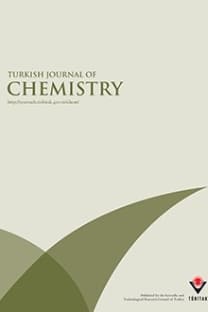Immobilized metal ion affinity nanospheres for a-amylase immobilization
a-Amylase, nanospheres, IMAC, enzyme immobilization, adsorption
Immobilized metal ion affinity nanospheres for a-amylase immobilization
a-Amylase, nanospheres, IMAC, enzyme immobilization, adsorption,
___
- Schenck, F. W.; Hebeda, R. E. Starch Hydrolysis Products: Worldwide Technology, Production and Applications, VCH, New York, 1992.
- Windish, W. W.; Mhatre, N. S. Advances in Applied Microbiology, In: Wayne, W. U. Ed., 1965.
- Fogarty, W. M.; Kelly, C. T. In Topics in Enzyme and Fermentation Biotechnology ; Wiseman, A., Ed., 1979.
- Vihinen, M.; Mantsala, P. Crit Rev. Biochem. Mol. Biol. 1989, 24, 329–418.
- Lonsane, B. K.; Ramesh, M. V. Adv. Appl. Microbiol. 1990, 35, 1–56.
- Nikolov, Z. L.; Reily, P. J. In Biocatalysts for Industry ; Dordick, J. S., Ed. Plenum Press, New York, 1991.
- Liu, Y.; Jia, S.; Ran, J.; Wu, S. Catal. Commun. 2010, 11, 364–367.
- Yamamoto, T. In Handbook of Amylases and Related Enzymes: Their Source, Isolation Methods, Properties and Applications; Amylase Research Society of Japan, Ed., Pergamon Press, Oxford, 1988.
- Bahar, T.; Celebi, S. S. Enzyme Microb. Technol. 2000, 26, 28–33.
- Roig, M. G.; Kennedy, J. F.; Garaita, M. G. J. Biomater. Sci. Polym. Ed. 1994, 6, 661–673.
- Ida, J.; Matsuyama, T.; Yamamoto, H. Biochem. Eng. J. 2000, 5, 179–184.
- Yang, Y.; Chase, H. A. Biotechnol. Appl. Biochem. 1998, 28, 145–154.
- Chen, J. P.; Sun, Y. M.; Chu, D. H. Biotechnol. Prog. 1998, 14, 473–478.
- Bryjak, J. Bioprocess Eng. 1995, 13, 177–181.
- Mateo, C.; Palomo, J. M.; Fernandez-Lorente, G.; Guisan, J. M.; Fernandez-Lafuente, R. Enzyme Microb. Technol. 2007, 40, 1451–1463.
- Akgol, S.; Ozturk, N.; Denizli, A. J. Appl. Polym. Sci. 2010, 115, 1608–1615.
- Cong, L.; Kaul, R.; Dissing, U.; Mattiasson, B. J. Biotechnol. 1995, 42, 75–84.
- Tischer, W.; Kashe, V. Biotechnology 1999, 17, 326–335.
- Ye, P.; Xu, Z. K.; Che, A. F.; Wu, J.; Seta, F. Biomaterials 2005, 26, 6394–6403.
- Rebros, V.; Rosenberg, M.; Mlichova, Z.; Kristofıkova, L. Food Chem. 2007, 102, 784–787.
- Sankalia, V.; Mashru, V.; Sankalia, J. M.; Sutariya, V. B. Eur. J. Pharm. Biopharm. 2007, 65, 215–232.
- Peng, K.; Hidajat, K.; Udin, M. S. J. Colloid Interface Sci. 2004, 271, 277–283.
- Choi, S. W.; Kwon, H. Y.; Kim, W. S.; Kim, J. H. Colloids Surf. A 2002, 201, 283–289.
- Ozturk, N.; Akgol, S.; Arisoy, M.; Denizli, A. Sep. Purif. Technol. 2007, 58, 83–90.
- Kim, J.; Grate, J. W.; Wang, P. Chem. Eng. Sci. 2006, 61, 1017–1026.
- Tuzmen, N.; Kalburcu T.; Denizli A. Process Biochem. 2012, 47, 26–33.
- Porath, J.; Carlson, J.; Olsson, I.; Belfrage, G. Nature 1975, 258, 598–599.
- Gaberc-Porekar, V.; Menart, V. J. Biochem. Biophys. Methods 2001, 49, 335–360.
- Arnold, F. H. Bio. Technology 1991, 9, 150–155.
- Gutierrez, R. E.; Martin del Vale, M.; Galan, M. A. Sep. Purif. Rev. 2007, 36, 71–111.
- Kubota, N.; Nakagawa, Y.; Eguchi, Y. J. Appl. Polym. Sci. 1996, 62, 1153–1160.
- Lawal, O. S. Food Chem. 2006, 95, 101–107.
- Ueda, E. K. M.; Gout, P. W.; Morganti, L. J. Chromatogr. A 2003, 988, 1–23.
- Mosbach, K. Sci. Am. 1971, 224, 26–33.
- He, D.; Cai, Y.; Wei, W.; Nie, L.; Yao, S. Biochem. Engineer. J. 2000, 6, 7–11.
- Tanyolac, D.; Yuruksoy, B. I.; Ozdural, A. R. Biochem. Eng. J. 1998, 2, 179–186.
- O’Neill, S. P.; Dunnill, P.; Lilly, M. D. Biotechnol. Bioeng. 1971, 13, 337–352.
- Lopez, G. P.; Ratner, B. D.; Rapoza, R. J.; Horbett, T. A. Macromol. Symp. 1993, 26, 3247–3253.
- Arica, M. Y.; Senel, S.; Alaeddinoglu, N. G.; Patir, S.; Denizli, A. J. Appl. Polym. Sci. 2000, 75, 1685–1692.
- Aksoy, S.; Tumturk, H.; Hasirci, N. J. Biotechnol. 1998, 60, 37–46.
- Turunc, O.; Kahraman, M. V.; Akdemir, Z. S.; Kayaman-Apohan, N.; G¨ ung¨ or, A. Food Chem. 2009, 112, 992–997. Kara, A.; Osman, B.; Yavuz, H.; Be¸sirli N., Denizli A. React. Funct. Polym. 2005, 62, 61–68.
- Chang, M. Y.; Juang, R. S. Process Biochem. 2004, 39, 1087–1090.
- Reddy, K. R. C.; Kayastha, A. M. J. Mol. Catal. B: Enzym. 1994, 38, 104–112.
- ISSN: 1300-0527
- Yayın Aralığı: 6
- Yayıncı: TÜBİTAK
Nedime DÜRÜST, Yaşar DÜRÜST, Emine Özge GÖZLÜKAYA
Immobilized metal ion affinity nanospheres for α-amylase immobilization
Adil DENİZLİ, Sinan AKGÖL, Münire Nalan TUZMEN, Tülden KALBURCU
Serkan EYMUR, Ayhan Sıtkı DEMİR, Mehmet GÖLLÜ
Guangjian WANG, Liancheng BING, Zhijian YANG, Jiankang ZHANG
On the peculiar reactivity of a C,N-annelated isoindole core
İaroslav BAGLAI, Valérie MARAVAL, Zoia Vsevolodivna VOITENKO
Şerife Zeybek VURAL, Göknur BAYRAM, Yusuf ULUDAĞ
Tuğba TÜĞSÜZ ARİFİOĞLU, Melis EFE ÇINAR, Nuray ŞATIROĞLU
Synthesis and antimicrobial activity of novel 2-[4-(1H-benzimidazol-1-yl)phenyl]-1H-benzimidazoles
Mehmet ALP, Ali Hakan GÖKER, Nurten ALTANLAR
